
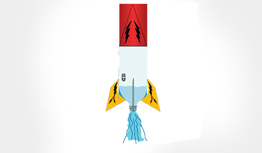
(Source: NASA)
Background:
A water rocket is a chamber, usually a 2-liter soft drink bottle, partially filled with water. Air is forced inside with a pump. When the rocket is released, the pressurized air forces water out the nozzle (pour spout). The bottle launches itself in the opposite direction. The bottle usually has a nose cone for streamlining and fins for stability. Water rockets are easily capable of 100-meter-high flights, but advanced hobbyists have combined bottles and staged bottles for flights over 300 meters high.
Water bottle rockets are ideal for teaching Newton’s laws of motion. The launch of the rocket easily demonstrates Newton’s third law. Students can see the water shooting out of the nozzle (action) and see the rocket streak into the sky (reaction). Students can also experiment with different pressure levels inside the chamber and different amounts of water. The rocket will not fly very high if it is filled only with air. The air will quickly rush out during the launch, but its mass is very low. Consequently, the thrust produced is also low (Newton’s second law). By placing water in the bottle, the air has to force the water out first before it can leave the bottle. The water increases the mass expelled by the rocket, thereby increasing the thrust.
Like all rockets, the flight performance of water bottle rockets is strongly influenced by the rocket’s design and the care taken in its construction. Bevelling the leading and trailing edges of fins allows them to slice through the lays out an entire process for air more cleanly. Straight-mounted fins produce little friction or drag with the air. A small amount of ballast weight inside the nose cone helps balances the rocket. This moves the centre of mass of the rocket forward while still leaving a large fin surface area at the rear. In flight, the rocket design acts like a weather vane, with the nose cone pointed up and the fins down.
Description:
Using plastic soft drink bottles, cardboard or Styrofoam food trays, tape, and glue, small teams of students can design and construct rockets. A simple assembly stand assists them in gluing fins on their rockets, and a nose cone is mounted on the top. A small lump of modelling clay is inserted into the nose cone to enhance the rocket’s stability in flight. The rocket is launched with a special launcher. The plans for the launcher are found in the Water Rocket Launcher activity.
Items needed:
Steps:
1. Collect 2-liter soft drink bottles a few weeks before the activity.
2. Save the caps
3. Thoroughly clean the bottles, remove the labels & glue adhesive on the bottle.
4. Construct assembly stands out of small blocks of wood.
5. Attach a bottle cap to the middle of each board with a small screw and a washer through the cap. The blocks also make a convenient way of storing the rockets upright when not being worked 
6. Pre-cut the PVC segments. The cuts can be slanted to streamline them. A saw or PVC cutter is used for cutting. 
The segments act as launch lugs to guide the rocket up the launch rod during the first moments of the rocket’s skyward climb
7. Be sure to use low- temperature glue guns. High temperature guns will melt the plastic bottle.
(A small dish of ice water in a central location is helpful for students who gets hot glue on their fingers. Immersing the fingers will immediately chill t he glue. Do not put bowls of water near the guns themselves because the guns use electricity for heating & shorting could occur if they get wet).
Procedure
1. Set up a supply station with materials such as Styrofoam food trays, poster board, tape, sandpaper, and art supplies.
2. Set up a gluing station with several heated low-temperature glue guns and extra glue sticks.
3. Divide students into teams for constructing rockets. If using Project X-51, describe the project to them and explain its objectives. Discuss construction techniques for their rockets. Give each team an assembly stand and a 2-liter soft drink bottle. Project X-51 requires teams to keep track of the materials they used. Even if they are not doing the project, it is still good for teams to account for the materials used.
4. Show teams how to use the glue guns and point out the cold-water dish in case glue gets on fingers. Students should wear Eye protection when gluing.
5. Describe how fins can be smoothed with sandpaper to slice through the air with little drag.
6. Remind teams to add clay to the inside of their nose cones
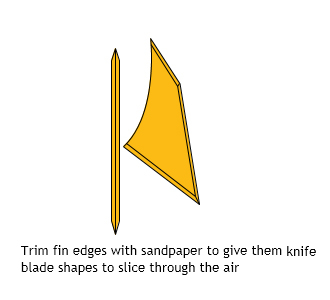 |
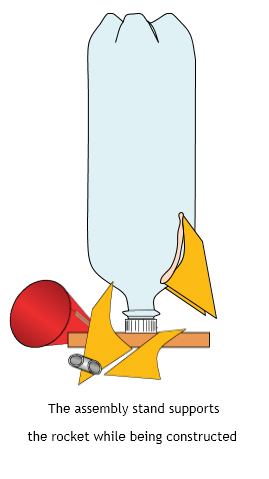 |
7. Have teams glue launch lugs to the side of the rocket midway up the body of the rocket and position it midway between two fins.
8. Challenge teams to think up a way to add a parachute to their rockets for soft landings. Plastic grocery bags or lightweight fabric scraps can be cut to make parachutes and strings can be used to attach them. The nose cone must remain in place until the rocket reaches the top of its flight; then it should open and release the parachute. Launch Lug 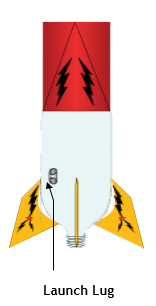
9. When the rockets have been completed, have teams qualify their rockets for flight by conducting string tests. Using several feet of string, tie the rocket around the middle so that it balances. Because of the nose cone weight, the balance point will be towards the nose. When the rocket hangs level, a small piece of tape should be temporarily fixed to the string and bottle to keep the string from slipping. The rocket is then twirled in a circle. If the rocket tumbles while circling, it is not stable and needs more nose cone weight, bigger fins, or a combination of both. If the rocket circles with the nose always pointed forward, it is stable and ready for flight. Clear an open space for swing tests 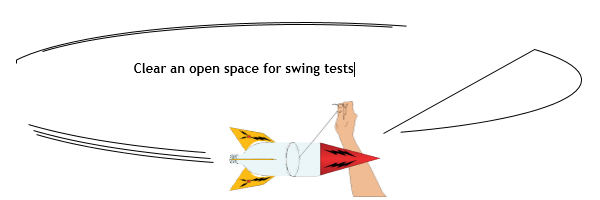
10. Review launch procedures with the teams. The instructions are outlined in the activity for constructing a water rocket launcher. Conduct an inspection the day before the launch to ensure that rocket fins are securely attached.
11. Set up a tracking station for measuring the altitudes achieved by the rockets. Follow all safety procedures and instructions when launching the team rockets.
Assessment:
Regd. Office :
Vikram Sarabhai Science Park, Plot No. 10/870,Thengode P.O
Kakkanad,Kochi -30, Mob: +91 9745377791, 8943233388
E-mail: info@vssf.in, spotnational@vssf.in
Terms of Use | Privacy Policy | Contact Us
© 2025 www.vssf.in All Rights Reserved
Designed and Developed by websoultechserve.com